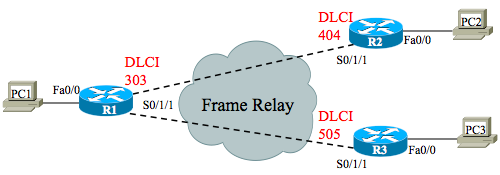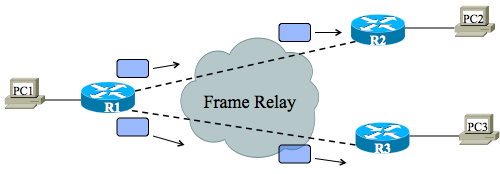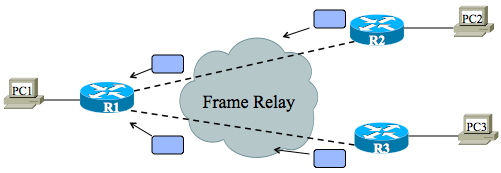FR DLCI Drill #1
This is the first of post of a new type of practice drill a Frame Relay DLCI Drill, or FR DLCI Drill for short. The short version: even if you only think about local DLCI concepts, people often get confused about how FR DLCIs work. Then when you add the whole global DLCI idea on top of it all, it gets more confusing. Then when you try to start with a lab, and figure out what to configure, the concepts blur.
This new type of drill is designed to give you some examples where you can apply what you have already learned, force you to think, force you to apply your knowledge, so that you confirm what you really know, and uncover what you don’t. Over time, I hope to create enough of these for any CCNA or ICND2 candidate can work through these when prepping for the exams.
Details below the fold. This is the first one, so any comments on style or features are timely. Enjoy!
Each FR Drill starts with documentation, with a simple figure. Your first job is to determine whether the figure shows local or global addressing. Then, to help you understand those concepts better, you should document the DLCIs with the other style. That is, is the first figure showed Global DLCIs, then you should list a new figure with local DLCIs, and vice versa. For instance, the first such drill uses this initial doc:
Figure 1 – Initial Documentation, FR Drill 1

This first step can often be a problem. If unsure, pick one, and work it out from there. Don’t just stop there!
Note that because the whole “global DLCI” idea is actually a DLCI assignment and documentation convention, it is possible for the provider to assign local DLCIs ignoring those rules, so that you cannot create a figure that shows global DLCIs. I won’t show one of those for the first few drills, but I will eventually.
The next phase is to list the encapsulation on the links, at least the DLCIs. When R1 sends a message to R2 over the FR network, what DLCI is in the header when R1 sends it? And what DLCI is in the header when R2 receives it? Figure 3 (yes I skipped some numbers on purpose) shows the idea, where you will essentially list the DLCI you expect to be in the header at each step.
Figure 3 – Predict DLCIs in the Header: Left to Right

You should also predict the DLCIs in the header when the frames flow right to left. Simple enough. Figure 4 shows the locations again, for reference.
Figure 4 – Predict DLCIs in the Header: Right to Left

Here are the steps in briefer form. I’ll use something like this for upcoming FR DLCI drills. Now you have the info to do the drill, and the list of tasks below. Post questions or comments if you have them, and leave the answers out of the subject line!
- Does the supplied figure show local DLCIs, global DLCIs, or is it impossible to tell?
- Create a new figure. If Figure 1 listed local DLCIs, list global DLCIs on the new figure, or vice versa.1
- Think about Frame Relay frames going left to right in Figure 3. List the DLCI(s) that will exist in each FR header, going into the FR network and exiting the FR network.
- Think about Frame Relay frames going right to left in Figure 4. List the DLCI(s) that will exist in each FR header, going into the FR network and exiting the FR network.
1Note that if Figure 1 lists local DLCIs, it may not be possible to list global DLCIs, depending on whether the example uses DLCIs that support the global DLCI assignment strategy.

[…] Feel the need to work through how Frame Relay DLCIs work? This is a way to apply those ideas and prove you know how DLCIs really work. Now that I’ve posted the first drill of this type, I’ll keep the instructions on this one short. Short version: I’ll give some a little FR documentation, and you tell me other facts about the FR network: global DLCIs, local DLCIs, and what DLCIs sit in the FR headers as the frames pass through the FR network. Check out the first one in the series for a little more background. […]
Fig 1 shows global DLCI
Fig2 with local DLCI would look like : 404 ——————— 303 (R2)
(R1)
505 ——————— 303 (R3)
Fig3 & 4 : Path of DLCI in header will follow DLCI representation as shown above i.e
404 303 and 505 303 —->
Sharad,
I agree. Thanks!
Wendell
All,
The answers post didn’t link here correctly… here it is:
http://ccnaskills.com/2012/01/09/answers-fr-dlci-drill-1/
Wendell
[…] An earlier pair of posts on the global DLCIs used in this exercise […]